So you’ve seen the videos. You’ve seen the locals tear up wave after wave and you’re tired of just watching from the sand. It’s finally time. You want to take on the swell for yourself. Be warned young grasshopper, learning to surf is a long journey that will test you both physically as well as mentally. But I assure you it’s worth it.
So how do you surf exactly? Learn to surf by starting out the right way, proper conditioning and practice, practice, practice. Everyone has a different learning curve, but starting your surf journey the right way can make all the difference. From there on, it’s just a matter of being a creature of habit and determining how bad you really want it.
How To Choose The Right Surf Spot
First and foremost, you should only be surfing at spots that are clearly known for being friendly to beginners. If you’re from somewhere like Rhode Island like I am, you won’t have too much trouble finding beaches with relatively mild waves. If you’re unsure, ask around at your local surf shop where beginners should surf. They will be happy to point you to an appropriate spot. If you can’t find any advice that seems reliable, go online and search for recommendations there. You will often be able to find discussion boards for local surfers that have good information.
You should also play it safe when you’re first starting out. If there is a lifeguard tower, plan to surf at a time when the lifeguard is on duty. Take some time to ask other surfers on the beach if they have any advice or warnings for you. In terms of what kind of waves you should be surfing, you should absolutely start surfing on Beach Break waves.
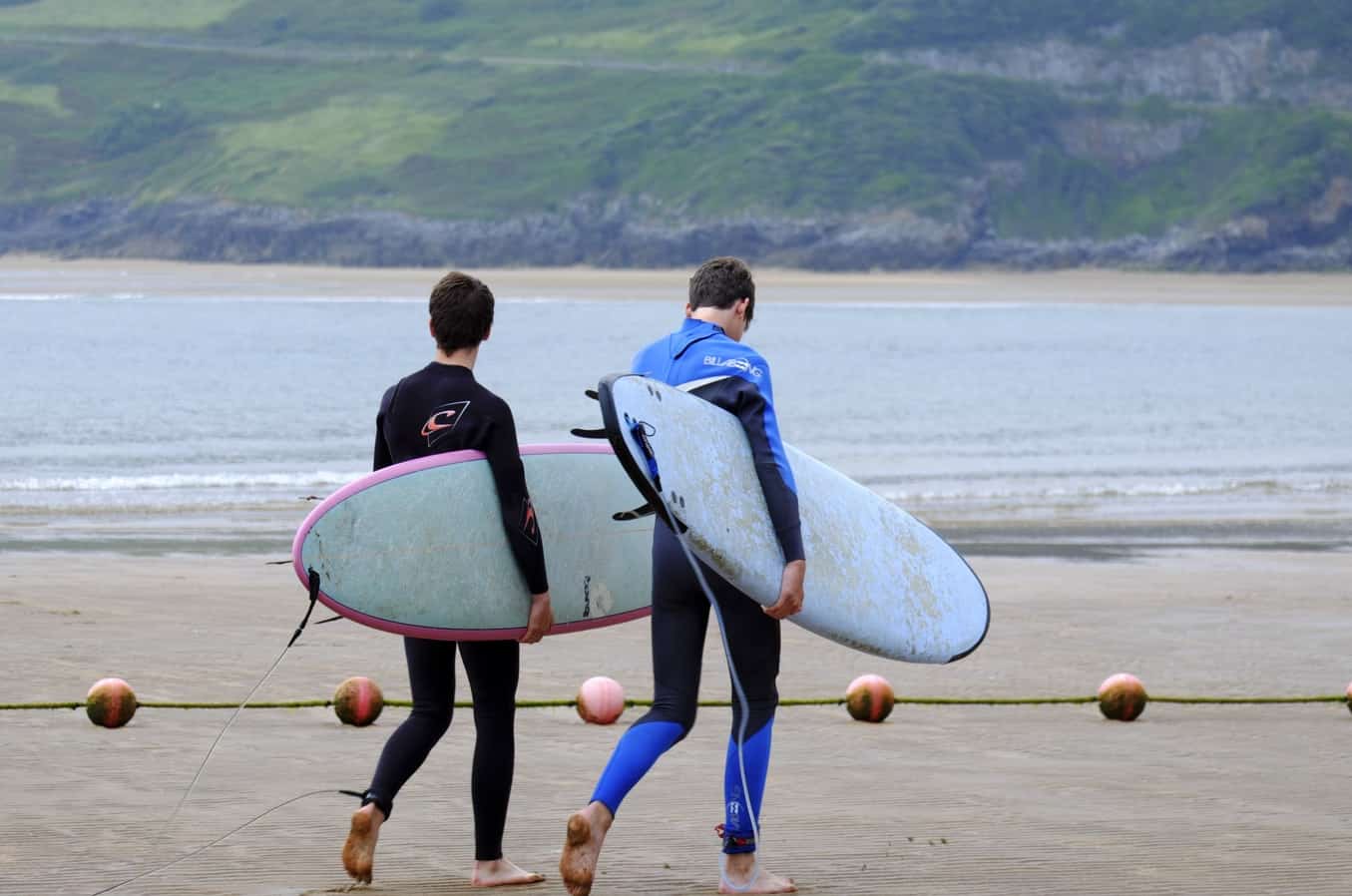
A Beach Break is a surf-able wave that breaks onto a beach. It is also the most common type of wave surfers encounter. The wave is created by the shallow bottom covered in sand or by the wave forming against the shoreline. This type of break is ideal for beginner surfers because you don’t have to paddle for miles to get beyond the break. Beach break waves do not always break as softly as point break waves or reef waves but wiping out on a beach break tends to be a lot more forgiving.
For beach breaks a low to medium tide is preferable for catching the best waves. Generally, the best times to surf are early in the morning around sunrise and sunset for it is far more likely that the waves will be clean and “glassy” aka consistently easier to surf. It is worth mentioning that every surf spot has its own particular schedule with many other factors at play, like onshore wind, offshore wind and swell. So before you choose a surf sport, make sure it’s a clean beach break and that you go at the right times. This will go a long way when you’re learning to surf.
How To Choose The Right Board
I won’t sugarcoat it. Surfing isn’t the cheapest hobby. A beginner’s surfboard may cost you between $300 and $1,000 or more. However, there’s no need to purchase a professional or brand name surfboard at the beginning of your journey. You will only wear it out as you gain experience. You may even find that surfing isn’t for you, so don’t waste your money in the beginning.
When it comes to beginner surfboards, larger surfboards are usually better. When you’re first starting out their easier to balance on and pop up on. You should also consider a big foam board to catch the waves easily and ensure you don’t get hurt if you spend the entire day falling off your board. These soft top surfboards or foamies can even cost less than 100 bucks!
So when you first start, get yourself on a big board. It’s a typical rookie mistake to get out on a brand-new, expensive shortboards and just spend the whole day wiping out. There’s absolutely no shame in starting on a ten-foot soft-top longboard that’s easy to paddle and stable to ride. By doing this, you’ll get lots of practice learning to read the ocean and popping up with ease. Then, when you’re more skilled, you can get your first serious board. Here’s a brief breakdown of the options for surfboards:
Shortboards are generally six and a half feet or shorter, with very little volume, usually with a tri-fin setup, designed for high-performance surfing with faster turns and more speed in larger waves.
Mini Mal, Mini Tanker, Funboard, Fish, Egg, Bonzer: are all names of boards that are smaller than eight feet and as small as five feet. They usually have a little more volume to make it easy to paddle into smaller waves, while being more maneuverable than a longboard.
Then there are Longboards: Generally nine feet and up, these either have a single-fin setup (best for nose riding and a classic style of surfing) or tri-fin setup (can be easier to turn and facilitate a more high-performance style of longboarding). Longboards easier to learn on than shortboards because they are easier to paddle, better on small surf and have thin noses that catch bigger waves. If you don’t get a soft-top board, most would suggest you learn on a longboard.
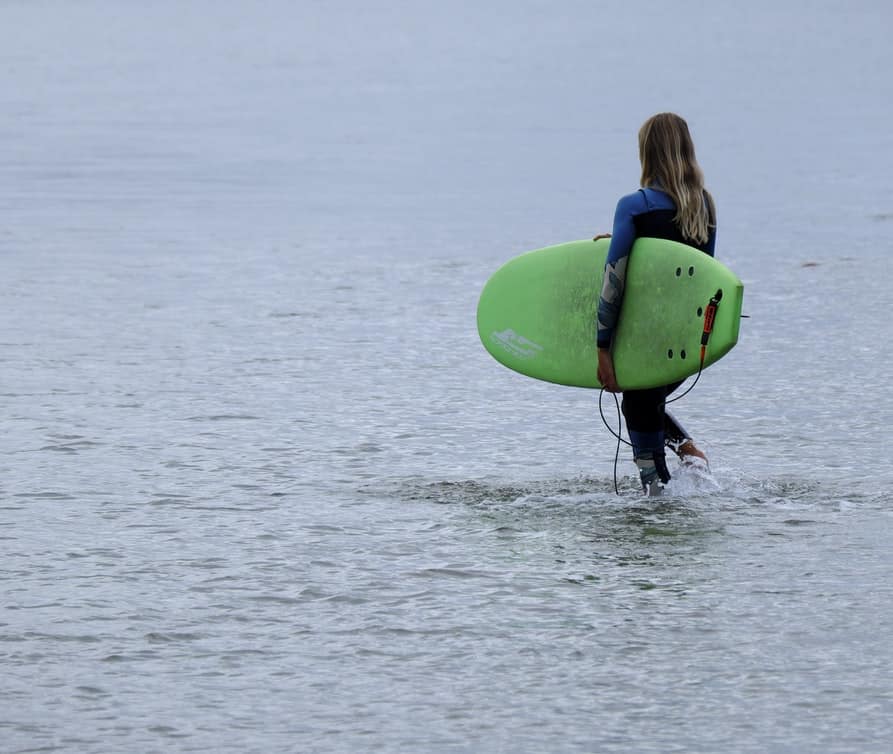
If you’re on the fence about really getting into surfing I recommend you rent a soft surfboard or foamie your first time out. Don’t feel pressure to invest in your own surfboard if you’ve never tried surfing before. At most beaches good for surfing, rental spots will be available close to the beach, offering reasonably cheap rental options, by the hour or by the day.
You’ll usually be able to choose between fiberglass boards and soft surfboards, sometimes called soft tops or “foamies. Soft surfboards are lightweight and much cheaper than epoxy or fiberglass boards. Soft boards are extremely buoyant and durable, making them a good choice for beginners.
Your size and weight will contribute to determining which type of board you should learn on. The more weight you have, the bigger the board volume you will need. You may not have a good experience learning to surf if you are trying to learn on a board that is too small for you. If you’re not sure what you want, talk to people at the surf shop. Be honest and tell them that you’re a first-timer and you want to know what you need to get started. As I mentioned before, I suggest you try out a longboard while you’re first learning. Longboards are the oldest and longest type of surfboard commonly available, ranging from 8 to 12 feet (2.4 to 3.7 m) in length. While they’re not quite as maneuverable or versatile as other types of boards, longboards are often recommended for beginners because of their ease of use.
So don’t worry too much about the aesthetics of the board. You’ll have plenty of time to work your way up to a shortboard. Shortboards, which are less than seven feet long, have a sharp nose and multiple fins. It takes more practice to master a shortboard than longer types of surfboards, but it is considered the definitive high-performance board for the pros and seasoned veteran surfers. You also shouldn’t worry too much about what boards you’ll want to be surfing down the road, as most experienced surfers have several boards in their arsenal. Different spots and weather conditions call for different boards, so only worry about what you need in the present as you’ll definitely need it again.
Why Taking Surfing Lessons Is A Great Idea
A good rule of thumb here is to take a surf lesson at a local surf school. The instructors will have a wealth of expertise, be able to steer you in the right direction in terms of what board fits your body type best and are usually very affordable! The average surfing lesson costs anywhere from $25 to $100 depending on the popularity of the lessons. Surfing lessons that run one to two hours long can cost as low as in the $10 to $20 range. They’ll teach you a ton, help you figure out the perfect board for you and get you on the right track as you embark on the long journey to become a competent surfer.
Other Gear You’ll Need
The beauty of surfing is that, besides a board, you need very little gear. A swimsuit that will stay put, a snug rash guard to keep from getting sunburnt or having your torso chafed. In many places, a wetsuit is just as essential as the board itself to ensure an enjoyable surfing experience. The wetsuit keeps your body warm in cold water, helping prevent chills and hypothermia. If the local surf shop recommends a wetsuit, get fitted and rent or purchase one before you hit the beach. Wetsuits usually cost between $100 and $300.
You’ll also need some surfboard wax. Surfboard wax is an important and inexpensive product that can be rubbed onto the top of a surfboard to increase foot grip, allowing better balance in the water. Ask your surf shop which type is appropriate for the temperature of the water you will be surfing in. And hey good news! Surf wax is dirt cheap. Just make sure not to get the wax sandy! This makes it very abrasive and can hurt like a mother when your bare chest rubs against it.
What To Do Once You’re At The Beach
Before paddling out, spend at least 30 minutes watching the surf. Pay attention to watch where other surfers paddle out, where the waves are breaking, and the ability level of the people in the water. Are they all very advanced, or are there beginners as well? You need to make sure that the waves are a comfortable size for you and sometimes it takes 30 minutes or more to see how big the bigger sets are. Once you paddle out, sit off to the side and watch for a little longer, noting where people are catching waves.
How To Find Your Footing On A Surfboard
If you’re learning at a surf school, this the very first lesson, is to lay your surfboard on the sandy beach itself and practice popping up by pressing your hands into the ground or board beneath your chest and, in one burst, jumping to your feet.
Like skating, both your feet must be centered on the width of the surfboard. Your feet arches should be positioned equally on each side of the stringer. Not standing up with your feet centered will most likely make you fall on the side on which you put more weight. Like almost every board sport, you have to figure out if you surf goofy or regular.
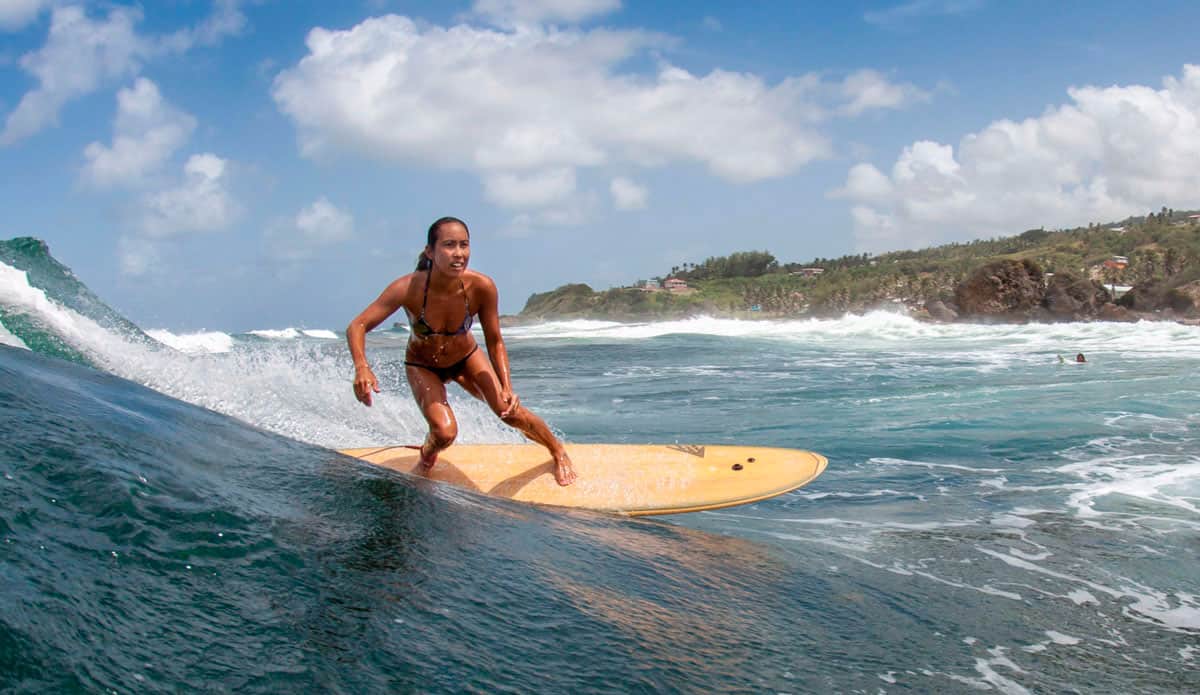
A “Regular Surfer”, surfs with their left foot forward on the board. A “Goofy Surfer” surf with your right foot forward. Skate stances abide by the exact same terminology. In most cases, surfers ride with their strongest foot (the foot you play with in soccer) at the back of the surfboard. However this isn’t always the case. For instance, I’m right foot dominant in soccer and ride goofy in both longboarding and skateboarding. A trick to figure this out is to have someone push you gently in the back. The first foot you instinctually put forward to stop you from falling will most likely be the one you put forward on the surfboard.
How To Practice Popping Up
Getting up or popping up on the wave and standing up on the board takes practice. And you can even practice on land! Lay the board down on the sand and place your hands below your chest, palms on the flat of the board while your fingers curl over the sides of the surfboard.
In one quick motion, push your body up with your arms and tuck your feet up and under you. Place one foot where your hands pushed up from and the other at least a shoulder’s width behind. Never grab the rails, or edges, of the board during your take off, unless you want to get a nice gash on your chin when your hands slip off your rail.
If you find your hands or feet slipping when you try to get up, you may need to rub more wax on your board. Beginners also tend to adopt a “squatty” stance where their feet are widely spread apart from bow to stern of their boards. This might feel comfortable, but it actually makes it harder to control. Balance is side-to-side, not front to back. You will notice that experienced surfers usually ride with their feet much closer together. A proper stance includes keeping your eyes looking in the direction you are going.
When you’re first starting out, try riding in the white water aka the very end of a wave’s crash towards the shore. It’s a great way to practice balancing on the board, getting a feel for paddling and popping up. Though riding these small wave endings isn’t the most exciting thing in the world, the thrill of popping up properly and getting even a little speed is super encouraging when you’re first starting out. It’s best to start in the white water to get the feel of surfing as most surf schools have you master the white water before paddling out beyond the break. Just make sure you’re not surfing into anyone, as people are more likely to be around because you’ll be so close to the shore.
How To Paddle Out
The next step is to paddle around and get comfortable in the water. The only way to find the “sweet spot” on your board is to take it into the water and paddle. Your board should plane across the water, the nose slightly above the water. A good go-to balance position is having your toes touching the leash string. If your nose is too high up, you’re too far back on the board. If it digs water, you’re too far forward. It is essential to find the sweet spot, as that is where you will achieve maximum paddling efficiency. Paddle with long, deep strokes from as far forward to as far back as you can comfortably reach.
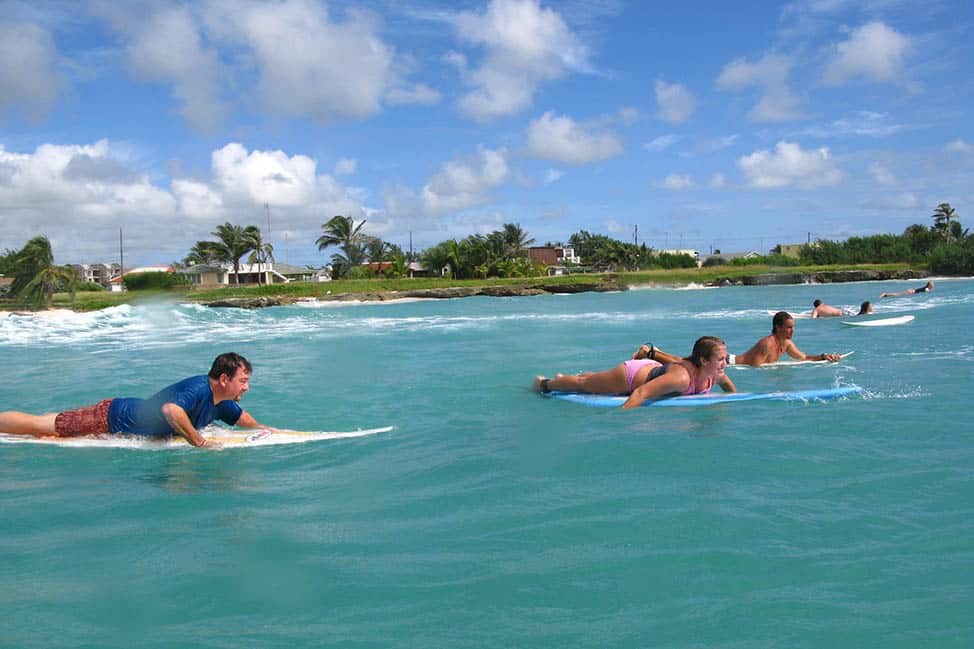
The next step is to paddle out to the lineup by respectfully using the shoulders of the lineup as opposed to paddling straight into the lineup. Don’t fret too much about this at first, as locals will know you’re a beginner, don’t waste energy trying to hide this as it’ll be obvious but it’s totally fine, everyone starts somewhere. Just try your best to stay out of your fellow surfers’ way to both be respectful and keep everyone safe.
How To Get Beyond The Break
The hardest part about learning to surf aside from catching the wave itself is properly putting yourself in the right position to catch them in the first place. The first part of this is paddling beyond what surfers call “the break”. The break is the invisible where the waves generally begin to form and break. The lineup is the space just beyond the break where surfers hang when waiting for a quality wave. But getting there requires awareness, physical prowess and endurance.
When waves are too big to ride over, you’re going to have use a technique to get past it without being pushed back significantly far. One technique and the technique you’ll likely be using as a beginner, is the turtle roll. Turtle rolls are generally more associated with longer boards, which is actually how I first learned to combat waves while getting beyond the break for the first time. Grab close to the nose and try to keep your toes connected to the board for stabilization. Pull the board down as the wave hits. Paddle until a bigger wave gets close you, turtle then paddle some more until you’re beyond the break.
How To Catch A Wave
Once the lineup clears up and you see the wave you want to catch, turn around and face the nose of your board toward the shore, then lay down and paddle like hell. Make sure the nose of your board is not underwater or too high in the air, it should just graze the surface.
You’ll slowly get some momentum going with the same direction of the wave. It’s important to conserve a burst of energy for just the right time: get in position, and line up the wave using a final “sprint” of paddle power that you have enough speed to. When the wave starts to draw on your tail and lift the back of your board as it rolls under you, kick it up to 80 percent and then save the last few strokes for 100 percent effort.

After a few strokes, look back over your shoulder to gauge where the wave is behind you, but continue paddling forward. The crucial part is that you’re not too far in front of the wave and not too far outside, but this comes with practice and experience in understanding the waves. You also need to make sure that the tail of your board is perpendicular to the wave as you paddle toward shore. The swell does not always come in parallel to the beach, so looking back and lining up with the wave is key.
How To Pop Up On A Wave
Look forward, and use your peripherals to sense where the wave is. When you feel a burst of speed and momentum, it’s the right time to stand up. Dropping in feels like a mini rollercoaster drop. That’s when you stop paddling and get ready to stand up. The first time I did this I was actually in free fall for a second and was absolutely shocked at how fast I went. I had bombed some huge hills downhill skateboarding and had been plaining (when you skip across the water) pretty hard windsurfing but this was faster. Way faster. But don’t get psyched out when you drop in. Focus and remember the next step. Pop up.

When you pop up, calmly look ahead and fully commit. Press your hands into the ground or board beneath your chest and, in one burst, jump to your feet. Try to hop up all in one motion. Hesitation creates instability. Always keep your eyes up and forward. Never look down at your feet, back at the wave, or at the nose of your board.
How To Ride A Wave
Once you’re up the wave will come crashing right behind you. Keep your feet planted on the board, your knees bent, your arms loose and your eyes looking in the direction you are going. You should also hold your arms out to your sides to balance. And voilà! You’re surfing. Stay focused and let it carry you in to shore. Enjoy the ride but always remember to keep an eye out for others in the water while you are surfing.
Start simple. At first, you should ride each wave straight in. This is a shorter and slower way to ride than angling on a wave, but it is easier to get the hang of. When you’re ready, you can try turning. The general rule here is to either ride the wave straight down towards the beach or use your feet, hips and arms to turn the board away from the direction the wave is crashing (right or left). The first time I caught a larger wave I’ll be honest, I just kinda guessed which way the wave was crashing and lucked out! So don’t be afraid to take a leap of faith and try to ride across a wave as opposed to straight down it.
Respect Surf Etiquette
Basically, every rule of surf etiquette comes down to doing your best to not get in other surfers way as they are riding waves. The first thing you can do here is to avoid paddling right into the impact zone. Don’t paddle directly into where most waves are crashing and where the majority of surfers are riding. Instead, paddle wide through the channel where the waves don’t break. When it’s hard to do this on beach breaks with waves breaking all over, try your best to paddle out where fewer surfers are riding.
You should also try not to get in the surfer’s line. As you paddle back, you might find yourself in front of a surfer riding a wave towards you. You must try to avoid getting in his way, by either paddling for the white water, or further out on the shoulder if that is possible. You don’t want to be attempting to make it over the wave, barely making it over the lip, only to ruin the surfer’s enjoyment of the wave.
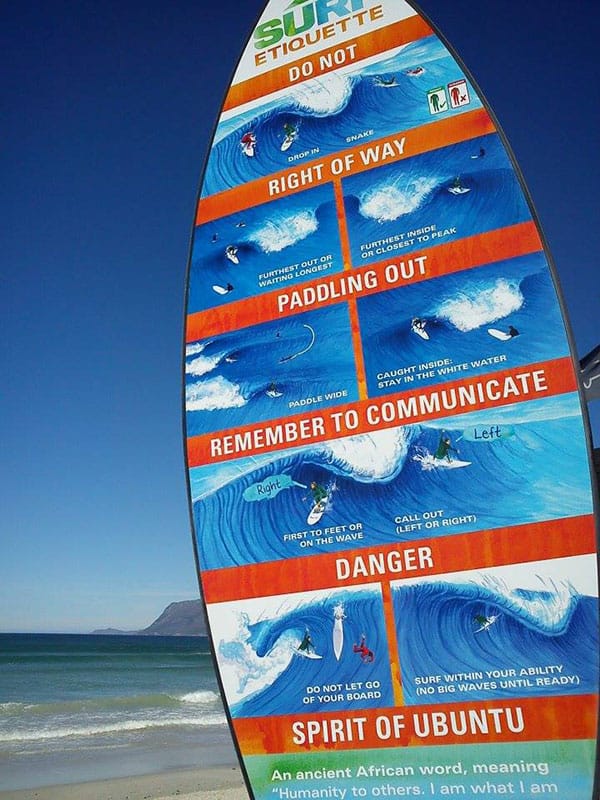
You should always respect the right of way. When there is more than one surfer paddling to catch a wave, the person who has paddled closest to the peak has the right of way for that wave. There’s a saying in surfing: “If in doubt, don’t paddle out”. Surfing can easily be one of the most enjoyable experiences of your life, but like any sport, you need to stay honest with yourself and your ability. Because surfing is practiced in the ocean, it can get quite dangerous if you are out in the water in surfing conditions you aren’t comfortable with. Don’t ride waves you can’t handle yet.
When you surf, there will likely be other surfers out at your spot, wanting to catch the same waves as you. When this happens remember that the surfer closest to the peak has the right of way. In other words, the surfer who has the longest potential ride has priority for the wave. This means the surfer closest to the peak (aka the breaking part of a wave) has the right of way because he is the one who will enjoy surfing the wave’s shoulder for the longest ride. If you disobey this rule, you may risk dropping in on someone who was also planning to ride the wave, which is not only frowned upon but an enormous safety risk.
How Do I Avoid Dropping In On Someone?
Dropping in is a big taboo is surfing. But let’s face it. You’ll probably drop in on another surfer at least a few times in your life. This happens to everyone. If it does, profusely apologize and tell them you’re a beginner. No harm no foul. But to avoid this, do the following. Look to the peak. As you paddle for a wave, always take a look at the peak to see if someone else is paddling for your wave and has the right of way. Remember to always check the opposite direction you want to go to before you chase a wave.
You can also get off the wave. Once you actually are on your feet and realize you have dropped on someone, it’s not too late to fix your mistake. You can probably just go over the shoulder and off back the wave, potentially not even disturbing the surfer with priority. The surfer as well as other surfers checking out the waves will appreciate your correction and dedication to etiquette and safety. And it’s really not the end of the world. There are plenty waves in the sea.
Respecting The Lineup
Surf spots with consistent takeoff zones offer the possibility of having every surfer taking turns. Taking turns means that surfers wait in the lineup and let each other take a wave, one after the other. The one who has been waiting the longest will sit at the end of the line, closer to the peak, and will be the next one to paddle for a wave.. The surfer paddling back from a wave respectfully sits at the end of the line up and will be the last one of the group to get a wave.
When spots are too crowded, which happens, lineups can fall apart because there are simply too many people in the water. In this case, the only rule that still stands is the drop-in rule. That is, don’t drop in on others.
Don’t Be Afraid To Wipe Out
In fact, prepare to wipe out. If you feel yourself falling, or if the wave dies down, jump away from the board towards the ocean and away from your momentum. Just accept it! A good idea is to fall to the side or the back of the board, covering your head with your arms as you fall. Go with the flow, letting the wave carry you. Swim upwards gently and feel what’s ahead of you to avoid getting hit by the board. And don’t feel bad about falling either. As a wise man once told me, if you ain’t falling, you ain’t learning.
When you land, try your best to land flat so that you won’t injure yourself in shallow water or on a reef. Once you have safely surfaced, pull your leash and climb back onto your board to prevent it from scything or flopping through the water, which can cause serious injury to you or others. Climb aboard, rest on your belly, and regain control.
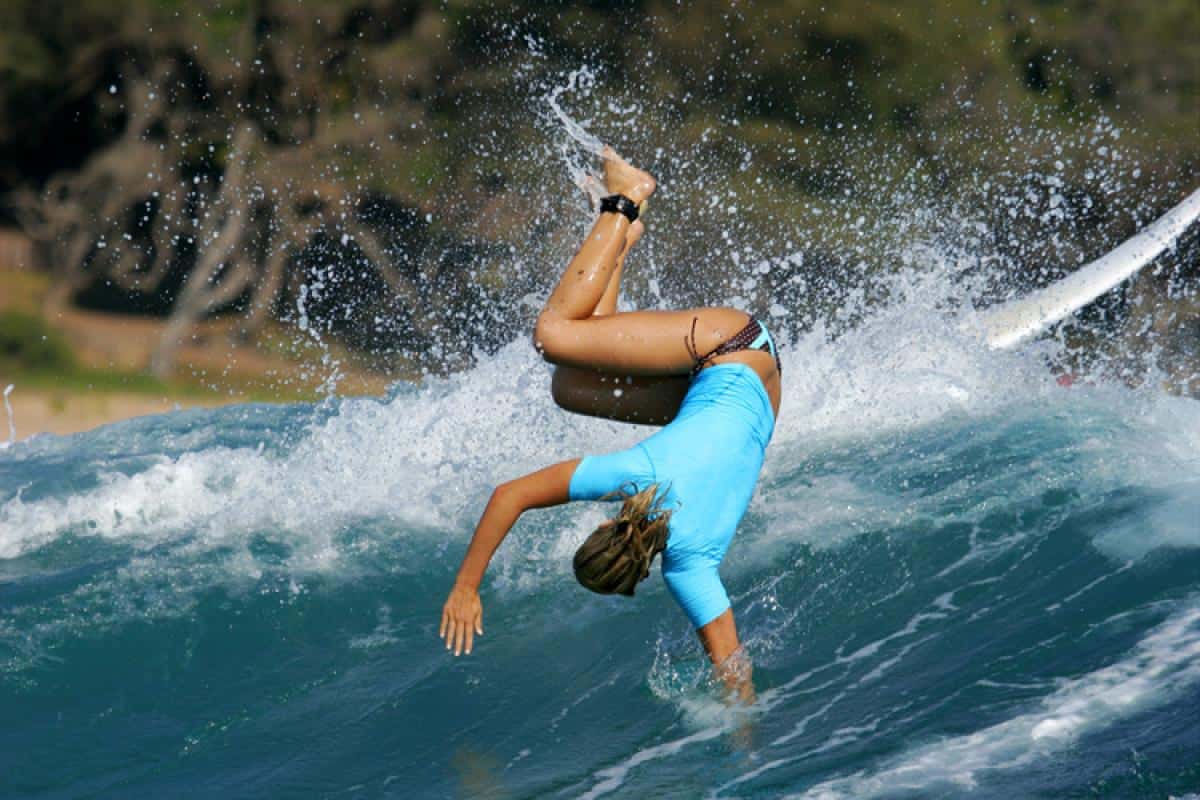
Most wipe out injuries happen as a result of the board hitting the surfer. Always remember to bail to the ocean side of your board. You don’t want to be between the beach and your board when a wave has control of the board. If you are riding for the very first time, it’s great to rent a foam surfboard rather than a fiberglass one, as they are softer and less likely to cause you injury while learning.
Keep At It
Keep trying. Fall down seven times, get up 8. Some people learn to surf in an afternoon, others take a few weeks to get the hang of things. Keep trying and you’ll eventually get it. You just have to be patient. In your first couple weeks, avoid stopping altogether a all costs. If you’re going to commit, really commit. The ocean isn’t gonna get any less merciless, so build up your strength, endurance and timing and get out there and conquer those waves.
Training for Surfing
Speaking of strength and conditioning, your first couple of sessions will probably have you tired in ways you never thought possible. This is because like swimming, paddling requires muscles that a lot of people wouldn’t normally use. It requires core control, as well as muscular endurance of the arms and back, plus strength in your legs, all while laying or standing on an unstable surface.
While surfing often is obviously the best way to get stronger, but that interval training and yoga for balance and flexibility are extremely helpful, too. When I attended a surf school in Nosara, Costa Rica the surf lessons were paired with two hour yoga sessions. While the overall benefits of yoga are significant themselves, I noticed that yoga tends to improve your core strength and balance really, really fast. Interval training is also a great way to get you ready for surfing because it’s like catching a wave, surfing the wave, and resting while waiting for another wave. Emulating the ups and downs of riding a wave can get your muscle memory up to speed for the next time you hit the waves.
There are three exercises that will help you prepare your body for surfing that stick out to me. The first is Dumbbell Front-Lateral Raises, which strengthen deltoid muscles aka the ones you use for paddling. Another good one is Barbell Romanian Deadlifts, which strengthens posterior chain muscles like your glutes, hamstrings and back. This exercise will generate powe that will help your body do turns more easily.
Last but not least, Core Rotations on a Swiss Ball is a great workout that will strengthen your core in a rotational movement for doing powerful turns and cutbacks. Be sure to alternate sides and use light to moderate weight progressively as your core gets stronger.
Other General Tips
Some general don’ts of surfing include the following. Never hold your board between you and the waves. Cover your head when you fall, particularly when you are separated from your board. This is a big one, as pretty much the worst possible situation is you get knocked unconscious by your board and drown. On a lighter note, always stretch, hydrate, and warm up before each surf session. And for good measure, stretch and hydrate and afterward, too! If you experience any serious pain, especially in your back or neck, stop immediately. It’s always better to be safe than sorry.
Final Thoughts
So if I’m being totally honest here, I had a unique learning curve when I learned in Nosara, Costa Rica. Not only was I already competent longboard skater but I was also a competent windsurfer. So though most of the boards I was windsurfing on were much wider and bigger than the surfboards I was learning on, I went in with a pretty damn good sense of board balance when it came to water sports and an even better sense of how to turn the surfboard from experience doing powerslides as a downhill skater.
That being said, the sensation and timing of catching a wave is completely unique to surfing. There is truly no other sport where the difference between even doing the actual sport and just sorta floating there is this drastic. How hard you have to paddle to catch a wave cannot be understated. Nor can the margin of error at every step of dropping in, popping up and riding the wave itself. To really surf, you must become a creature of habit. I highly recommend getting lessons and surfing multiple times a day, as I did. Signing up for a “surf boot camp” of sorts got my sea legs on the right foot and I haven’t looked back since.
The biggest advice I can give you as you start out is be relentless, don’t be discouraged and maybe more than either of those things; talk to your fellow surfers! You could be wiping out hard just because you’re riding the wrong kind of board or doing something weird with your feet when you pop up. Part of surf culture is the constant discussing of the ways you can get closer to that mythical perfect wave. So have fun, don’t give up and be yourself! Find your own style and preferences and tear up those waves like no one’s ever seen. Like the waves themselves, no two surfers are exactly alike. Be you. Everything else is just water. Happy surfing!

